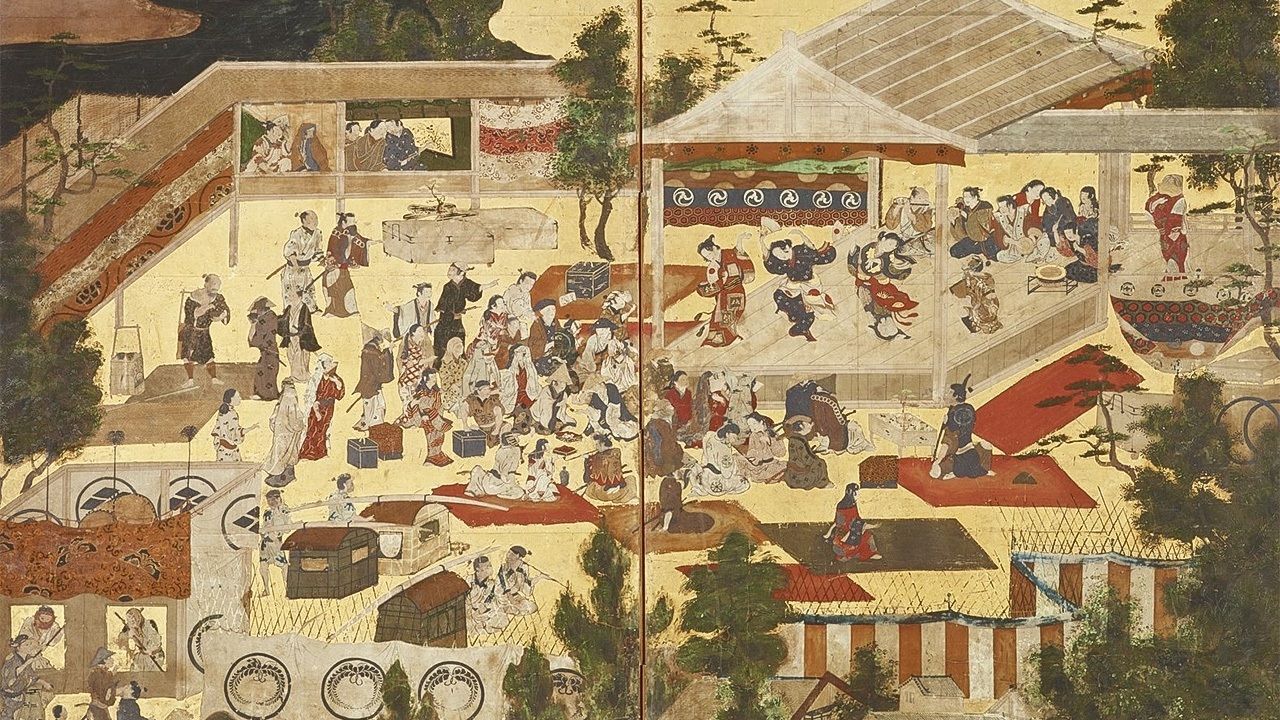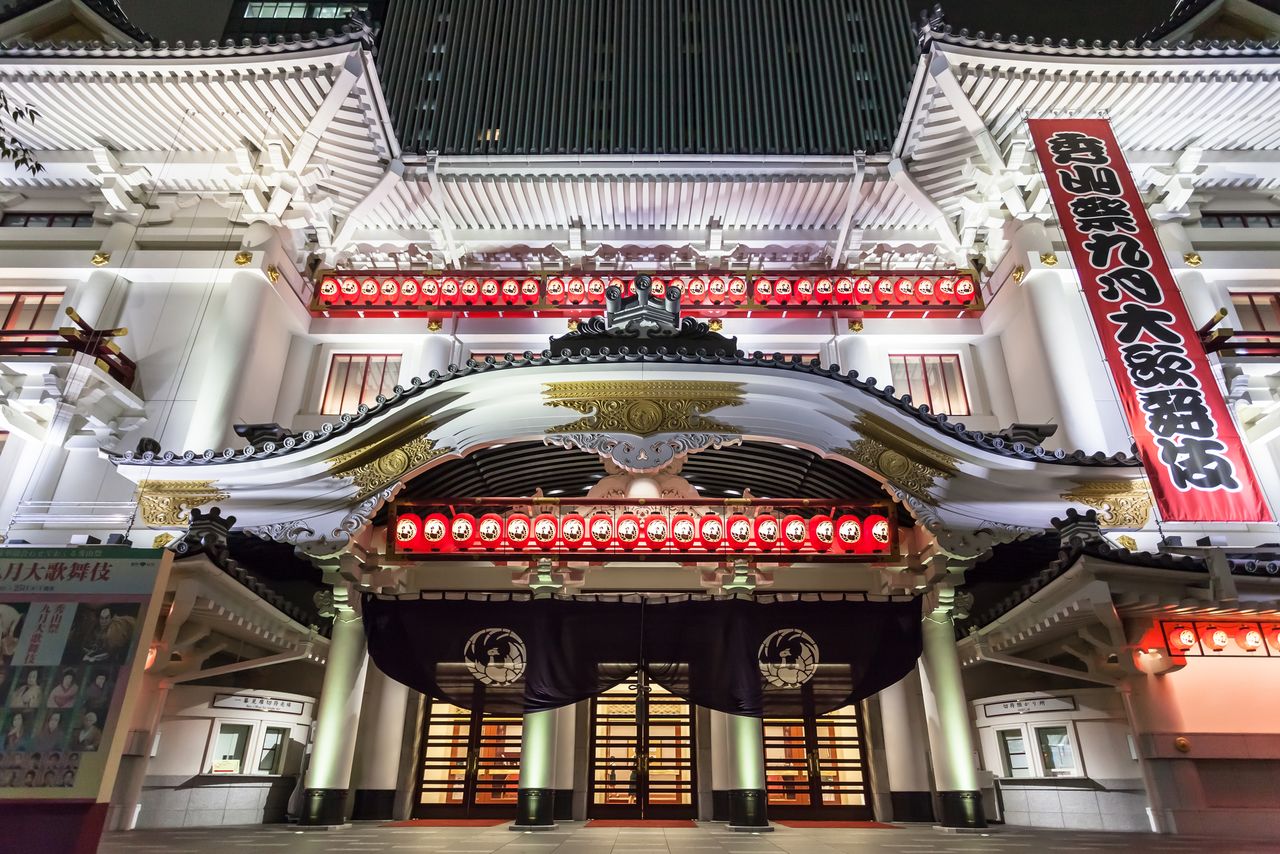
The Origins of Kabuki
Culture Art- English
- 日本語
- 简体字
- 繁體字
- Français
- Español
- العربية
- Русский
In the Beginning: A Woman Dancer
With its distinctive kumadori make-up, vibrant costumes, and dynamic action, the kabuki theater occupies a central position in Japan’s performing arts and is an immediately recognizable symbol of the country’s proud cultural traditions. Today, no women perform on the main kabuki stages—all the female roles are played by specialized male actors known as onnagata. But this was not always the case. In fact, the origins of kabuki can be traced back to a single woman, who created a new style of performance in the early years of the Edo period (1603–1868).
Her name was Izumo no Okuni, and she probably came originally from the province of Izumo (now Shimane Prefecture). She was one of a troupe of girls who performed ritual and ceremonial dances known as yayako-odori in the houses of the nobility in Kyoto.
After reaching adulthood, Okuni tried her hand at a bold new style of performance: a kind of comedy skit in which she dressed in imitation of the “kabukimono”—flamboyant figures who could often be seen in the Kyoto of her time, parading the streets in their colorful kimonos, large swords swinging at their sides, and engaging in playful banter with the madams of the pleasure quarter teahouses. The real-life kabukimono were disruptive figures—many of them rōnin or masterless samurai—who flouted social conventions with their outlandish behavior and unconventional style of dress. The term derives from the verb kabuku, meaning “to slant,” “to deviate,” or “to be off-balance.” In her performances, Okuni presented an exaggerated caricature of these kabukimono men, burlesquing their behavior and lampooning a certain kind of stereotypically “male” behavior.
Okuni’s daring performances, which subverted traditional gender roles, proved popular. Soon, other theatrical troupes in Kyoto began copying Okuni’s innovative style, and kabuki-odori became established as a distinct form of dance. This is the term that eventually gave us the modern word kabuki.

The Kabukiza theater in Ginza, Tokyo. (© Pixta)
Scandals and Suppression: Why Women Disappeared from the Stage
But if it was a woman who invented kabuki-odori and made it popular, why did the dance form evolve into modern kabuki, where all the roles are played by men?
One factor that had a huge impact was the introduction of sumptuary laws on behavior and morals by the Tokugawa shogunate. After unifying the country following more than a century of civil war in 1603, the first shōgun Tokugawa Ieyasu imposed all kinds of rules and restrictions on the conduct of the daimyō lords, desperate to establish a new order free from the chaos of war. But ordinary people felt the weight of these laws too. Many aspects of daily life and leisure—including the activities of the kabukimono rowdies lampooned by Okuni, the pleasure quarters they frequented, and theatrical performances themselves—soon came under strict government censorship and control.
Under the second Tokugawa shōgun Hidetada, the “prince” of the kabukimono, Ōtori Ippei, was arrested and put to death at the age of just 25. The brothels that had previously operated more or less at will across the country were corralled into licensed establishments under government supervision and restricted to specific designated areas.
At the time, theatrical performances took place outdoors, in places like riverbeds or temple grounds, with the audience sitting on the grass. This is reflected in the Japanese word for theater today (shibai), which derives from shiba, meaning “grass” or “lawn.” As government control tightened, even these simple stage performances needed permission from the bakufu (shogunate).
Several screen paintings from the early Edo period depict lively crowds enjoying the entertainments on offer along the Kamogawa River at Shijō Kawaramachi in Kyoto. In these images, the theatres lining the river are clearly marked with yagura (drum towers) that soar above the entrances, signifying that the operators had secured official government approval.
By this time, it is likely that Okuni, the originator of kabuki-odori, had already passed away. The theatrical style she pioneered had shifted, and it was now prostitutes from the pleasure quarters who took to the stage to perform what was known as onna-kabuki (women’s kabuki).
Although onna-kabuki became popular around the country, its close associations with prostitution led to its downfall. The dances increasingly served as advertisements for brothels, and the performances were often little more than a front for unlicensed prostitution. Repeated attempts by the bakufu to impose regulations proved ineffective. In 1629, under the third shōgun Iemitsu, a complete ban was imposed on women appearing on the public stage. Severe penalties were enforced against anyone who dared to break the new law, and brothels swiftly abandoned their theatrical sidelines to safeguard their main business. With this, women disappeared from the mainstream licensed kabuki stage.
From Women to Boys
But this was not the end of kabuki. Adolescent boys replaced women, and a new form of theater known as wakashū kabuki (boys’ kabuki) soon emerged. Wakashū referred to adolescents who had not yet come of age. In samurai culture, pederasty was a widely accepted practice known as shudō (the way of young boys), and adolescents were often the objects of romantic and sexual interest. The practice and its associated culture spread from the warrior class to the urban masses. It became known that the boys and young men performing in wakashū kabuki were available for sexual services, and the theater became closely associated with male prostitution.
The shogunate repeatedly issued laws banning shudō but public morals failed to improve. In 1652, under the fourth shōgun Ietsuna, a total prohibition was placed on wakashū-kabuki, and performances in all theaters were stopped. Unlike the licensed brothels, which operated under bakufu supervision and had a “legitimate” business to protect, the promoters of wakashū-kabuki had nothing else to fall back on. Determined to ensure the survival of their livelihood, they resorted to drastic measures. Performers were shorn of their youthful locks—a distinctive style that was a large part of the young actors’ charm—and were given adult hairstyles, with shaved pates and hair left only on the sides and back of their heads. The promoters then petitioned the bakufu to allow performances to resume, now that the actors presented a more respectable and less provocative appearance.
The next year, a new type of performance began, with bakufu approval. This yarō-kabuki (men’s kabuki) had little in common with the lubricious, innuendo-laden dance of earlier kabuki. Instead, the theaters now presented narrative-driven plays known as kyōgen-zukushi. Although wakashū continued to appear on stage playing women’s roles, they now wore pieces of purple fabric over their shaved heads and performed with a new emphasis on acting rather than erotic dancing. The male roles became increasingly specialized, and the plots of the plays grew longer and more complex. These changes laid the foundations for the kabuki theater we know today. Ironically, the strict censorship imposed by the shogunate ultimately gave kabuki a greater artistic sophistication and depth.
In this evolution toward greater refinement, women were excluded from kabuki, but they did not disappear from the scene altogether. Although banned from the “large theaters” (ōshibai) licensed by the bakufu, female performers continued to appear in smaller, temporary theaters, in traveling troupes, and in performances given in private residences (yashiki shibai). Many women also became successful teachers of dance and the shamisen. In the ōoku (women’s quarters) of the shōgun’s palace and daimyō mansions, where men were forbidden, women known as okyōgenshi put on polished performances of kabuki plays with all-female casts. Some of the actresses in these performances, perhaps a little like the Takarazuka theater troupe today, were said to surpass even the famous male actors of the licensed theaters.
Crossing Gender Boundaries
By the time the ban on women in the theater was finally lifted, traditions had solidified, and audiences were no longer receptive to the idea of women on the kabuki stage. By contrast, the Takarazuka Revue, founded in 1913 with an all-female cast performing both male and female roles, is probably more popular today than kabuki itself. Is it just coincidence that kabuki’s onnagata (male actors specializing in female roles) and Takarazuka’s otokoyaku (female actresses specializing in male roles) both emerged from the same theatrical tradition? Both push boundaries in their own ways. Perhaps something in Japanese culture or the national character is drawn to performances like these, which cross boundaries and challenge society’s sometimes rigid ideas about gender roles and identity.
(Banner image: Kabuki Performance (Edo period), from the exhibition “Kabuki Prints: First Exhibition of Treasured Ukiyo-e Prints” at Seikadō Bunko Art Museum from January 25 to March 23, 2025. Courtesy Seikadō Bunko Art Museum.)
